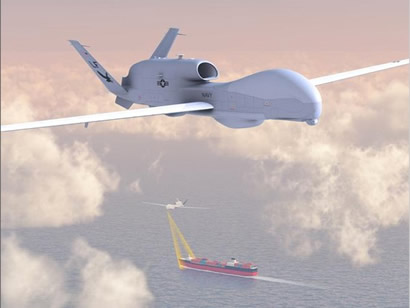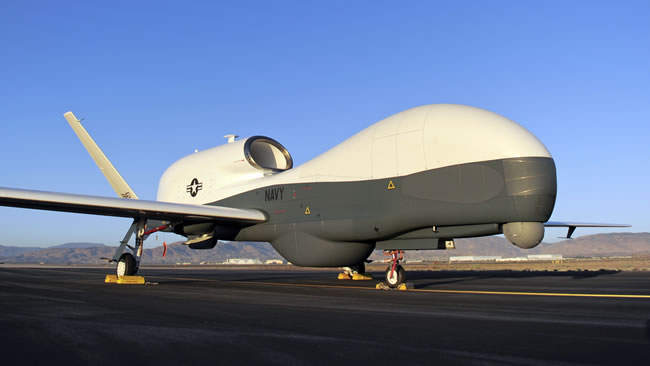
The MQ-4C Triton, only recently introduced, is a large, unmanned drone designed to provide enhanced maritime surveillance in coordination with the Navy’s P-3C Orion and P-8A Poseidon maritime surveillance/anti-submarine aircraft.
Guam’s Andersen Air Force Base (AFB) currently operates three Northrop Grumman RQ-4 Global Hawk unmanned aerial vehicles (UAV) in a limited surveillance role. The RQ-4 was designed primarily to perform land surveillance duties, not long-duration ocean surveillance sweeps.
In an interview with ABC News, intelligence analyst Matthew Aid said that the RQ-4 “was designed for pinpoint imagery or eavesdropping on land targets, by over flight, or by flying obliquely up to 450 kilometers off an enemy’s coastline” while the MQ-4C “was designed for broad area maritime surveillance – following ships from high altitude.”
Joe Gradisher, Public Affairs Officer for the Assistant Chief of Naval Operations Next Generation Enterprise Network (NGEN), recently told Stars & Stripes newspaper that the Navy’s Tritons would join the Global Hawks at Guam.
Mr. Gradisher told Stars & Stripes that current plans “for BAMS include the use of Guam, but other bases may be considered in the future, subject to combatant commander desires and future diplomatic arrangements.” The Japan Times newspaper and ABC News also reported the decision to base the Tritons at Guam.
As part of the United States’ “pivot” to the Asia-Pacific region, the US Navy is working towards reinforcing its maritime surveillance capability in the Pacific Ocean arena. Existing plans call for the new Boeing P-8A Poseidon Maritime Patrol/Anti-Submarine Warfare aircraft to be deployed as a replacement for the Navy’s venerable Lockheed Martin P-3C Orion maritime patrol aircraft.
The P-8A Poseidon is designed to operate with the Navy’s new MQ-4C Triton in an anti-submarine warfare (ASW) role that includes the interdiction of maritime shipping and performance of electronic intelligence (ELINT) functions. The P-3 has been in service with the navies of many nations since 1962 and is nearing retirement. The P-8s are expected to begin replacing some of the aging P-3s assigned to stateside squadrons next year.
Existing plans call for the acquisition of 68 Tritons and 117 Poseidons to replace the P-3C Orions still operational. By pairing the MQ-4C Triton BAMS drone with the P-8A Poseidon in the Pacific, the US Navy will be able to maintain a continuous long-range surveillance over a wide expanse of the Asia-Pacific region to an extent the P-3C Orions cannot match. As tensions between Japan, China, and other Asian-Pacific nations have continued to escalate and are beginning to pose a threat to regional peace, an enhanced surveillance force is a capability US Pacific commanders are anxious to get into operation.
There is also a very real possibility that Japan will be deploying its drones to Andersen AFB in the near future as well. Japan’s Kyodo News Service reported that the United States and Japan were discussing a proposal to jointly-base US and Japanese UAVs in Guam. The Japan Times newspaper also released a story, citing an anonymous source, stating that the Japanese Self-Defense Force (JSDF) was in negotiations with US representatives to arrange a joint-use arrangement that would allow the JSDF to operate drones from Guam.
The joint-use proposal, as reported by the Japan Times, would provide for the JSDF to share USAF/USN hangars, flight support, and maintenance facilities.
A previous Japanese proposal to buy Global Hawks was dropped because of cost considerations, but JSDF officials insist it is their desire to buy surveillance drones sometime between Fiscal Year 2014 and Fiscal Year 2020. The Japanese Maritime Self-Defense Force (JMSDF) currently operates 80 P-3C Orion maritime patrol aircraft, five EP-3C ELINT Orions, and four OP-3C reconnaissance models from various air stations throughout the Japanese Archipelago. These aircraft were built under license by Kawasaki Heavy Industries.
United States Navy officials and JMSDF officers are well aware that Japan’s fleet of Orions is not capable of providing the long-duration continuous surveillance of Pacific sea lanes needed to keep an eye on China’s rapidly-growing, technologically-advanced naval presence. A joint-basing arrangement would be advantageous to both nations with respect to cost-savings, workload reductions, information sharing, and joint-force readiness.
US military officials at Guam declined comment on the MQ-4C basing reports. Navy Lieutenant William Knight said that he could neither confirm nor deny the reports, but indicated that pertinent information could be forthcoming at a later date.




















